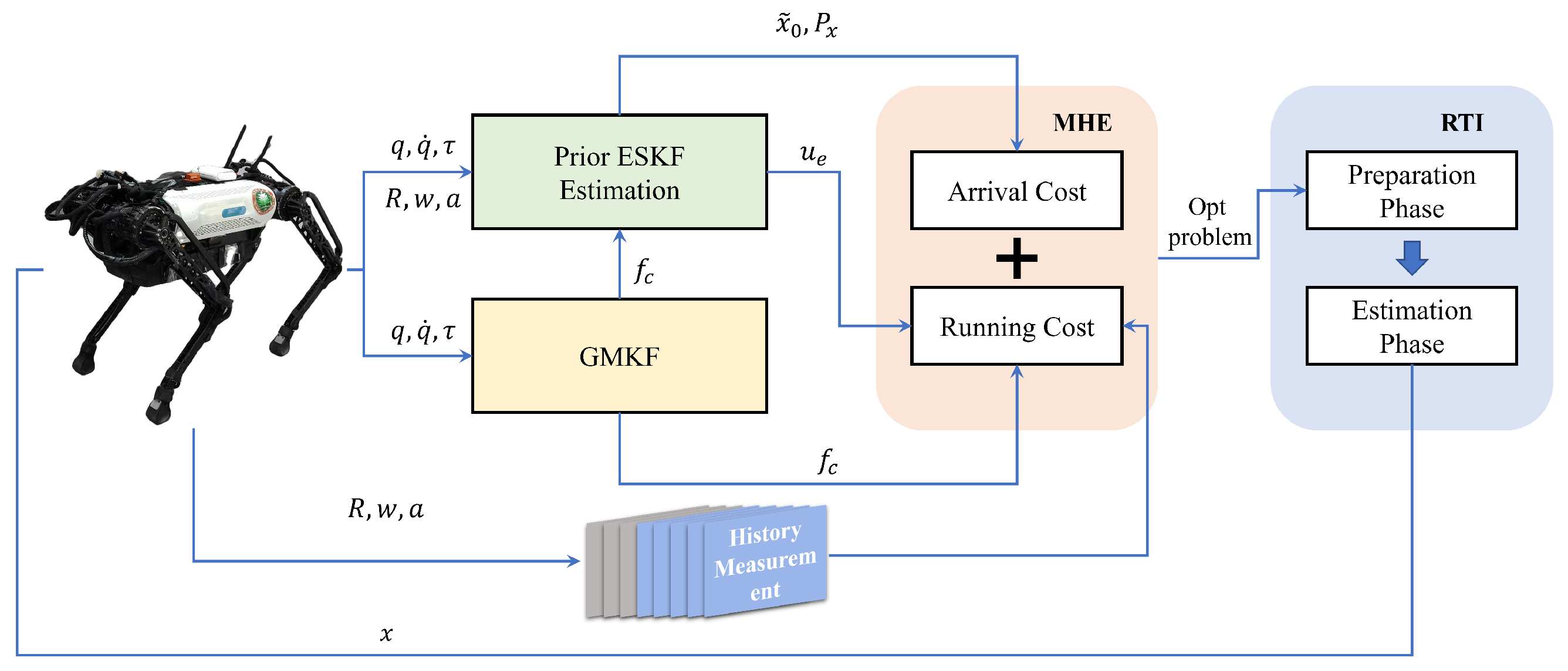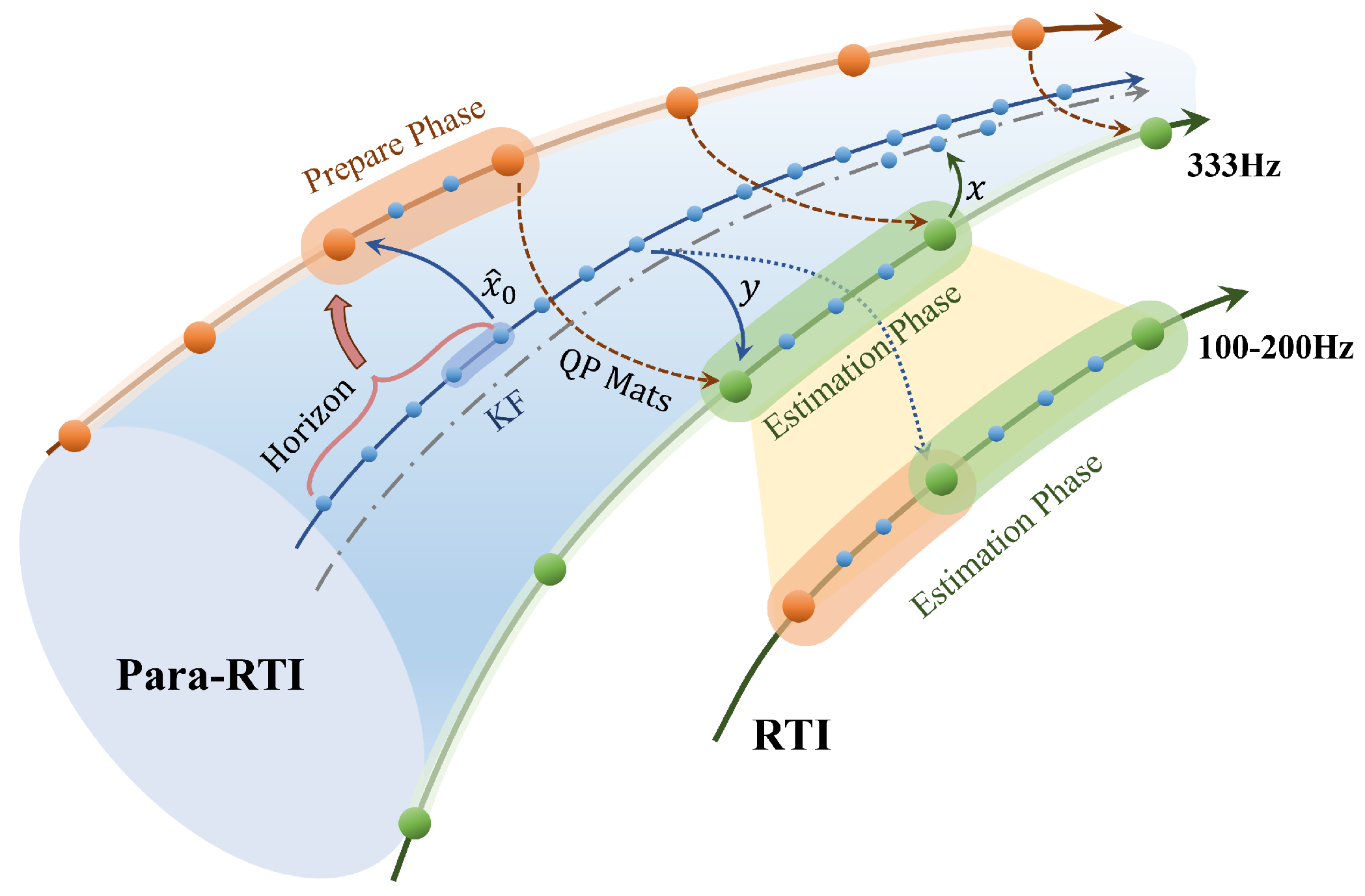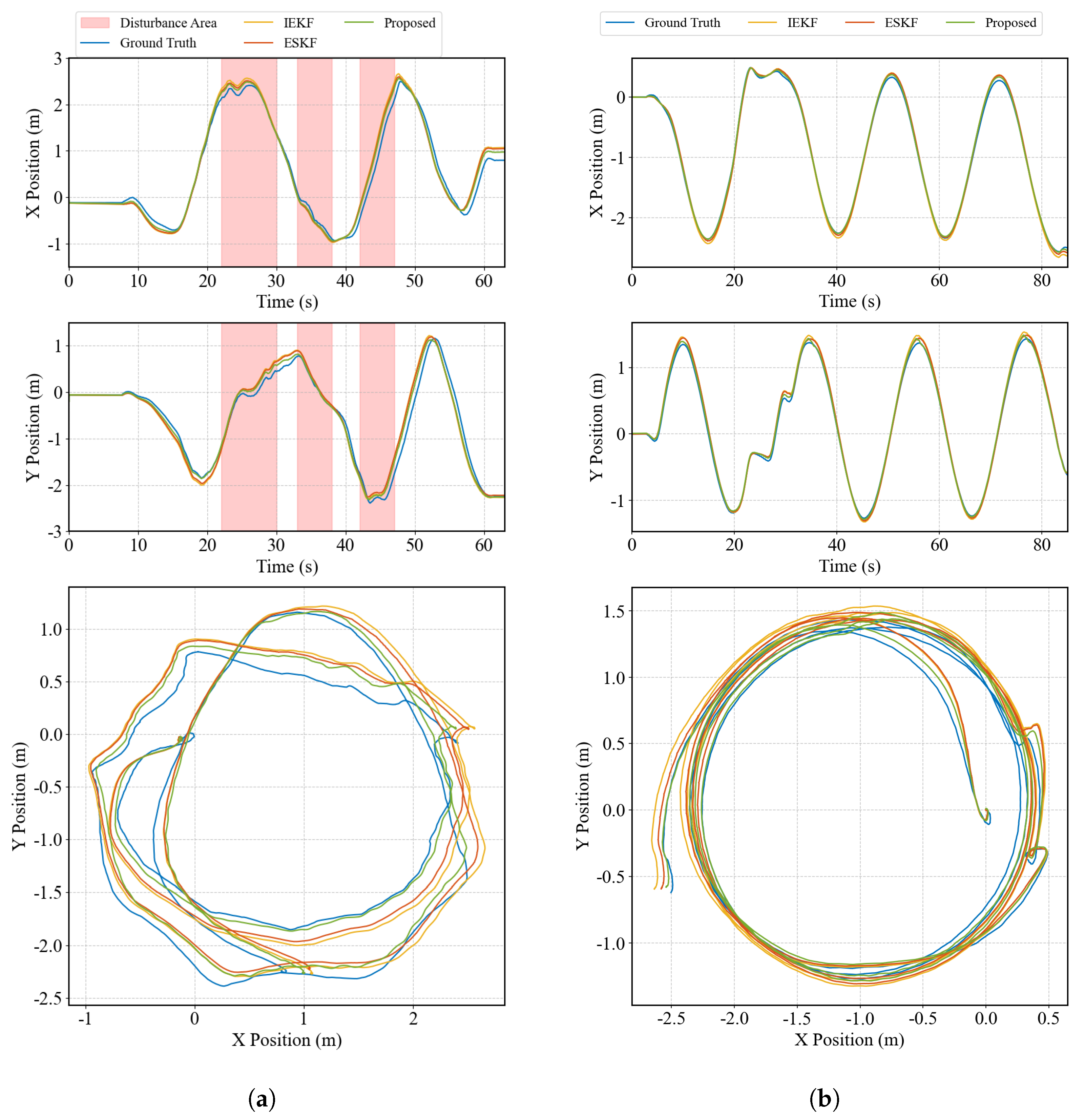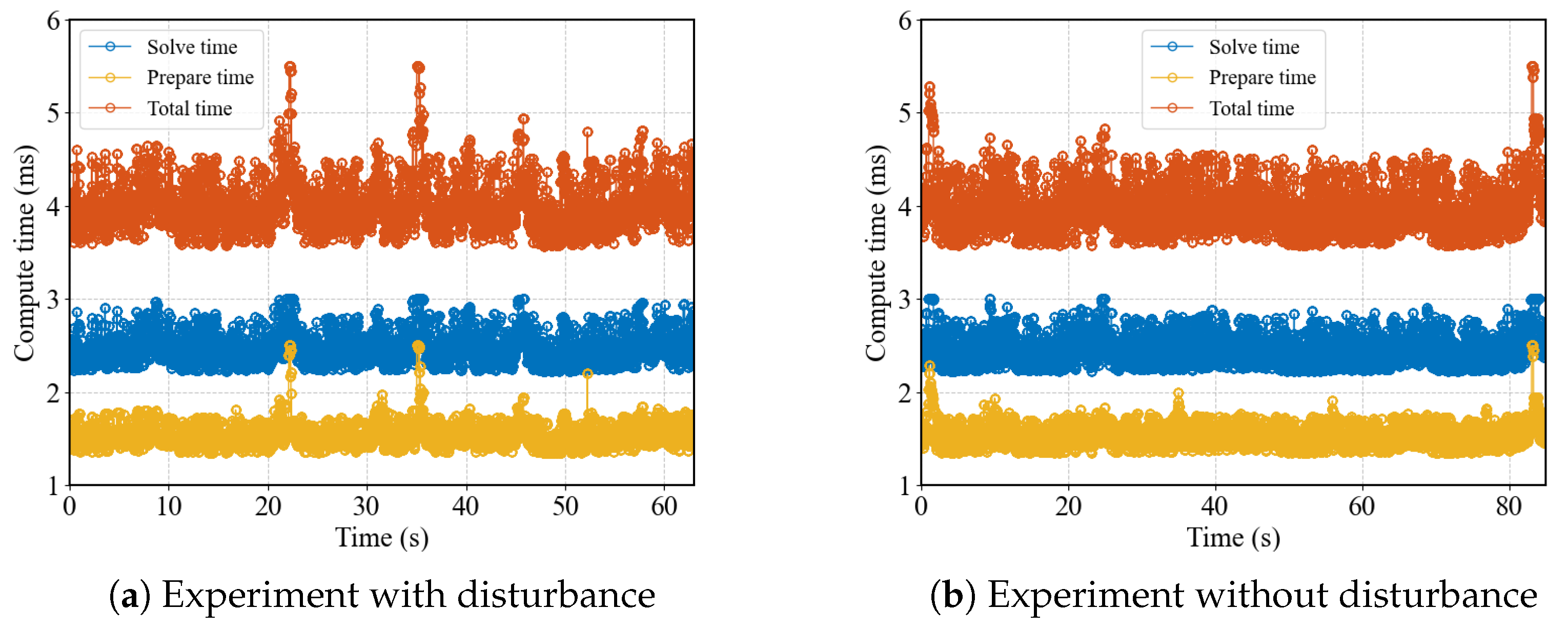Real-Time Cascaded State Estimation Framework on Lie Groups for Legged Robots Using Proprioception
Abstract
1. Introduction
2. System Modeling Using Canonical Coordinates of the First Kind
2.1. Cayley Map and Right-Trivialized Tangent
2.2. Configuration of Rigid Body on Lie Groups
3. Error-State Kalman Filter with Joint Torque
3.1. GRF Reconstruction
3.2. Error-State Kalman Filter
| Algorithm 1 Error-state Kalman filter with joint torque. |
| Initialize the state variable and covariance matrix |
| , |
| repeat |
| Compute state |
| Compute covariance estimation |
| Compute optimal Kalman gain |
| Update state estimation with measurement |
| Update covariance estimation |
| until stop |
4. MHE with Para-RTI
4.1. MHE
4.2. Para-RTI
| Algorithm 2 Para-RTI: Parallel real-time iteration for nonlinear MHE. | |
| 1: | Initialization: Initialize Kalman Filter (KF), Preparation Thread, and Estimation Thread |
| 2: | Main Thread: |
| 3: | while true do |
| 4: | Run Kalman Filters to obtain prior estimate , bias , and external wrench |
| 5: | Send KF results to Preparation Thread |
| 6: | Wait for sensor measurements and send sensor measurements to Estimation Thread |
| 7: | Receive estimated values from Estimation Thread |
| 8: | Update system state with estimated values |
| 9: | end while |
| 10: | Preparation Thread: |
| 11: | while true do |
| 12: | Wait for prior results from Main Thread |
| 13: | Evaluate objective in Equation (28a), constraints in Equations (28b)–(28d), and sensitive matrices in Equation (15) |
| 14: | Store evaluation results for Estimation Thread |
| 15: | end while |
| 16: | Estimation Thread: |
| 17: | while true do |
| 18: | Wait for sensor measurements from Main Thread |
| 19: | Retrieve evaluation results from Preparation Thread |
| 20: | Solve QP problem using evaluation results |
| 21: | Send estimated values to Main Thread |
| 22: | end while |
5. Experiments
6. Discussion
Author Contributions
Funding
Data Availability Statement
Conflicts of Interest
References
- Du, W.; Fnadi, M.; Benamar, F. Rolling based locomotion on rough terrain for a wheeled quadruped using centroidal dynamics. Mech. Mach. Theory 2020, 153, 103984. [Google Scholar] [CrossRef]
- Xu, K.; Wang, S.; Shi, L.; Li, J.; Yue, B. Horizon-stability control for wheel-legged robot driving over unknow, rough terrain. Mech. Mach. Theory 2025, 205, 105887. [Google Scholar] [CrossRef]
- Chen, L.; Ye, S.; Sun, C.; Zhang, A.; Deng, G.; Liao, T.; Sun, J. CNNs based foothold selection for energy-efficient quadruped locomotion over rough terrains. In Proceedings of the 2019 IEEE International Conference on Robotics and Biomimetics (ROBIO), Dali, China, 6–8 December 2019; pp. 1115–1120. [Google Scholar]
- Sola, J. Quaternion kinematics for the error-state Kalman filter. arXiv 2017, arXiv:1711.02508. [Google Scholar] [CrossRef]
- Hartley, R.; Ghaffari, M.; Eustice, R.M.; Grizzle, J.W. Contact-Aided Invariant Extended Kalman Filtering for Robot State Estimation. Int. J. Robot. Res. 2020, 39, 402–430. [Google Scholar] [CrossRef]
- Li, J.; Yuan, Z.; Sang, X.; Zhou, Q.; Zhang, J. Center of Mass Dynamics and Contact-Aided Invariant Filtering for Biped Robot State Estimation. IEEE Sens. J. 2023, 23, 27531–27539. [Google Scholar] [CrossRef]
- Wisth, D.; Camurri, M.; Fallon, M. VILENS: Visual, Inertial, Lidar, and Leg Odometry for All-Terrain Legged Robots. IEEE Trans. Robot. 2023, 39, 309–326. [Google Scholar] [CrossRef]
- Kim, Y.; Yu, B.; Lee, E.M.; Kim, J.h.; Park, H.w.; Myung, H. STEP: State estimator for legged robots using a preintegrated foot velocity factor. IEEE Robot. Autom. Lett. 2022, 7, 4456–4463. [Google Scholar] [CrossRef]
- Kang, J.; Kim, H.; Kim, K.S. VIEW: Visual-Inertial External Wrench Estimator for Legged Robot. IEEE Robot. Autom. Lett. 2023, 8, 8366–8373. [Google Scholar] [CrossRef]
- Yang, S.; Zhang, Z.; Bokser, B.; Manchester, Z. Multi-IMU Proprioceptive Odometry for Legged Robots. In Proceedings of the 2023 IEEE/RSJ International Conference on Intelligent Robots and Systems (IROS), Detroit, MI, USA, 1–5 October 2023; pp. 774–779. [Google Scholar] [CrossRef]
- Vukov, M.; Gros, S.; Horn, G.; Frison, G.; Geebelen, K.; Jørgensen, J.; Swevers, J.; Diehl, M. Real-Time Nonlinear MPC and MHE for a Large-Scale Mechatronic Application. Control Eng. Pract. 2015, 45, 64–78. [Google Scholar] [CrossRef]
- López-Negrete, R.; Biegler, L.T. A moving horizon estimator for processes with multi-rate measurements: A nonlinear programming sensitivity approach. J. Process Control 2012, 22, 677–688. [Google Scholar] [CrossRef]
- Diehl, M.; Ferreau, H.J.; Haverbeke, N. Efficient Numerical Methods for Nonlinear MPC and Moving Horizon Estimation. In Nonlinear Model Predictive Control; Morari, M., Thoma, M., Magni, L., Raimondo, D.M., Allgöwer, F., Eds.; Springer: Berlin/Heidelberg, Germany, 2009; Volume 384, pp. 391–417. [Google Scholar] [CrossRef]
- Khorshidi, S.; Dawood, M.; Bennewitz, M. Centroidal State Estimation based on the Koopman Embedding for Dynamic Legged Locomotion. arXiv 2024, arXiv:2403.13366. [Google Scholar] [CrossRef]
- Kang, J.; Wang, Y.; Xiong, X. Fast Decentralized State Estimation for Legged Robot Locomotion via EKF and MHE. arXiv 2024, arXiv:2405.20567. [Google Scholar] [CrossRef]
- Sola, J.; Deray, J.; Atchuthan, D. A micro Lie theory for state estimation in robotics. arXiv 2018, arXiv:1812.01537. [Google Scholar]
- Mangiacapra, G.; Wittal, M.; Capello, E.; Nazari, M. Unscented Kalman Filter and Control on TSE(3) with Application to Spacecraft Dynamics. Nonlinear Dyn. 2022, 108, 2127–2146. [Google Scholar] [CrossRef]
- Teng, S.; Chen, D.; Clark, W.; Ghaffari, M. An Error-State Model Predictive Control on Connected Matrix Lie Groups for Legged Robot Control. arXiv 2023, arXiv:2203.08728. [Google Scholar] [CrossRef]
- Agrawal, A.; Chen, S.; Rai, A.; Sreenath, K. Vision-Aided Dynamic Quadrupedal Locomotion on Discrete Terrain Using Motion Libraries. arXiv 2022, arXiv:2110.00891. [Google Scholar] [CrossRef]
- Müller, A. Review of the exponential and Cayley map on SE (3) as relevant for Lie group integration of the generalized Poisson equation and flexible multibody systems. Proc. R. Soc. A 2021, 477, 20210303. [Google Scholar] [CrossRef]
- Torrisi, G.; Grammatico, S.; Smith, R.S.; Morari, M. A Variant to Sequential Quadratic Programming for Nonlinear Model Predictive Control. In Proceedings of the 2016 IEEE 55th Conference on Decision and Control (CDC), Las Vegas, NV, USA, 12–14 December 2016; pp. 2814–2819. [Google Scholar] [CrossRef]
- Verschueren, R. Convex Approximation Methods for Nonlinear Model Predictive Control. Doctoral Dissertation, Albert-Ludwigs-Universität Freiburg im Breisgau, Freiburg, Germany, 2018. [Google Scholar]
- Gros, S.; Zanon, M.; Quirynen, R.; Bemporad, A.; Diehl, M. From Linear to Nonlinear MPC: Bridging the Gap via the Real-Time Iteration. Int. J. Control 2020, 93, 62–80. [Google Scholar] [CrossRef]
- Hespanhol, P.; Quirynen, R. A Real-Time Iteration Scheme with Quasi-Newton Jacobian Updates for Nonlinear Model Predictive Control. In Proceedings of the 2018 European Control Conference (ECC), Limassol, Cyprus, 12–15 June 2018; pp. 1517–1522. [Google Scholar] [CrossRef]
- Nurkanović, A.; Zanelli, A.; Albrecht, S.; Frison, G.; Diehl, M. Contraction Properties of the Advanced Step Real-Time Iteration for NMPC. IFAC-PapersOnLine 2020, 53, 7041–7048. [Google Scholar] [CrossRef]









| Proposed | ESKF | IEKF | |
|---|---|---|---|
| Position RMSE w/o disturbance (m) | 0.0292 | 0.0472 | 0.0539 |
| Velocity RMSE w/o disturbance (m/s) | 0.0565 | 0.0592 | 0.0594 |
| Angle RMSE w/o disturbance (rad) | 0.0376 | 0.0684 | 0.0687 |
| Position RMSE w/ disturbance (m) | 0.1278 | 0.1601 | 0.1841 |
| Velocity RMSE w/ disturbance (m/s) | 0.1232 | 0.1268 | 0.1262 |
| Angle RMSE w/ disturbance (rad) | 0.0677 | 0.1165 | 0.1085 |
Disclaimer/Publisher’s Note: The statements, opinions and data contained in all publications are solely those of the individual author(s) and contributor(s) and not of MDPI and/or the editor(s). MDPI and/or the editor(s) disclaim responsibility for any injury to people or property resulting from any ideas, methods, instructions or products referred to in the content. |
© 2025 by the authors. Licensee MDPI, Basel, Switzerland. This article is an open access article distributed under the terms and conditions of the Creative Commons Attribution (CC BY) license (https://creativecommons.org/licenses/by/4.0/).
Share and Cite
Liu, B.; Meng, F.; Zhang, Z.; Wang, M.; Wang, T.; Chen, X.; Yu, Z. Real-Time Cascaded State Estimation Framework on Lie Groups for Legged Robots Using Proprioception. Biomimetics 2025, 10, 527. https://doi.org/10.3390/biomimetics10080527
Liu B, Meng F, Zhang Z, Wang M, Wang T, Chen X, Yu Z. Real-Time Cascaded State Estimation Framework on Lie Groups for Legged Robots Using Proprioception. Biomimetics. 2025; 10(8):527. https://doi.org/10.3390/biomimetics10080527
Chicago/Turabian StyleLiu, Botao, Fei Meng, Zhihao Zhang, Maosen Wang, Tianqi Wang, Xuechao Chen, and Zhangguo Yu. 2025. "Real-Time Cascaded State Estimation Framework on Lie Groups for Legged Robots Using Proprioception" Biomimetics 10, no. 8: 527. https://doi.org/10.3390/biomimetics10080527
APA StyleLiu, B., Meng, F., Zhang, Z., Wang, M., Wang, T., Chen, X., & Yu, Z. (2025). Real-Time Cascaded State Estimation Framework on Lie Groups for Legged Robots Using Proprioception. Biomimetics, 10(8), 527. https://doi.org/10.3390/biomimetics10080527







